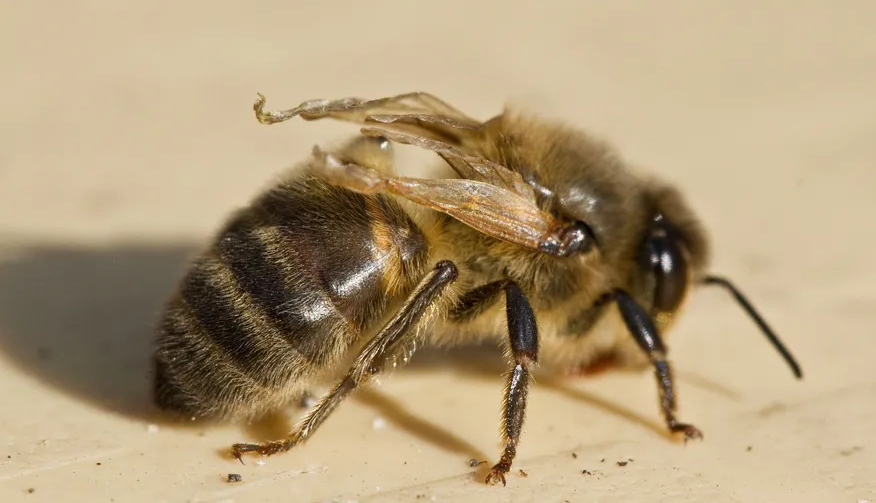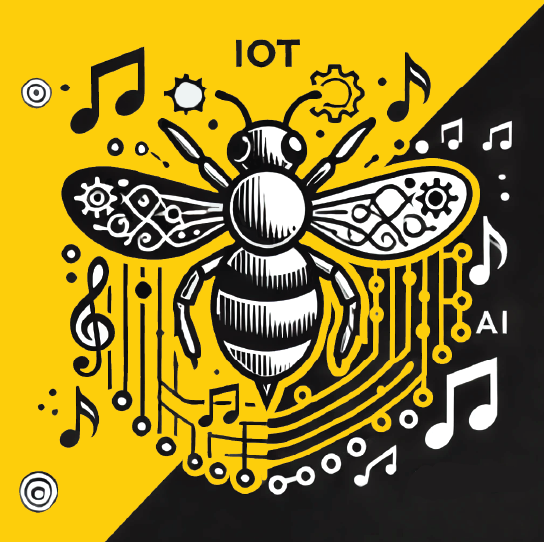Challenges
Understanding honey bee threats through sound.

Honey bees face numerous challenges in today's world, threatening their survival and our food security. These challenges can be categorized into the Four P's : Poor Nutrition, Parasites, Pathogens, and Pesticides. I’ll throw in a fifth, Predators. These factors rarely work in isolation—instead, they interact in complex ways that can devastate colony health. Our innovative acoustic monitoring technology offers the promise of an early alert solution, potentially before visible symptoms appear or an inspection takes place.
Poor Nutrition
Poor nutrition occurs when honey bees lack access to diverse, high-quality pollen and nectar sources. Modern agricultural practices, including monoculture farming and habitat loss, have significantly reduced the variety and availability of forage for bees throughout the year.
Inadequate nutrition weakens bees' immune systems, reduces their lifespan, impairs their ability to detoxify pesticides, and compromises colony development. Nutritionally stressed colonies produce fewer foragers and less honey and are more susceptible to diseases and parasites. This creates a cascade effect that can ultimately lead to colony collapse.
Current approaches include supplemental feeding with sugar syrup and pollen substitutes, planting pollinator gardens, and conservation efforts to preserve wildflower habitats. However, these solutions have limitations—artificial feedings often lack the full nutritional profile of natural forage, and habitat restoration takes time and significant resources.
We believe that our acoustic monitoring system will detect subtle changes in colony sounds that indicate nutritional stress before visual signs appear. By analyzing the unique acoustic signatures of hungry or nutritionally deficient colonies, beekeepers can intervene earlier with targeted feeding strategies or relocate hives to better forage areas.

Healthy comb with multicolored pollen stores
Parasites

Hive comb with Wax Moth larvae present.

Parasites, particularly Varroa destructor mites, represent one of the most significant worldwide threats to honey bee health. These external parasites feed on adult bees and developing brood, weakening them physically and introducing dangerous viruses. Other significant parasites include tracheal and Tropilaelaps mites, though the latter has not yet been established in North America.
Varroa mites act as vectors for multiple deadly viruses, including Deformed Wing Virus. They weaken bees by feeding on their fat bodies — critical tissues for immune function and winter survival. Heavy infestations can collapse a colony within weeks, and resistant Varroa populations have emerged against many treatment options, creating an ongoing arms race for control methods.
Current parasite management relies heavily on chemical treatments (synthetic miticides, organic acids, and essential oils) and cultural practices like drone brood removal and screened bottom boards. However, chemical treatments can contaminate honey and wax, while mites rapidly develop resistance. Biological controls show promise but aren't yet widely implemented or fully effective.
We are most interested in understanding which specific acoustic signatures are associated with Varroa infestation levels, especially before they become visible through traditional monitoring methods. Early detection allows for more timely and targeted intervention, potentially reducing the need for harsh chemical treatments and preventing colony losses.
Pathogens

Honey bee with Deformed Wing Virus (evident by misshapen wings)
Honey bees face a wide range of pathogens, including viruses (such as Deformed Wing Virus and Israeli Acute Paralysis Virus), bacteria (like American and European Foulbrood), and fungi (including Nosema species). These disease agents spread through the hive environment and between colonies through robbing, drifting, and beekeeping practices.
Pathogens compromise individual bee health and colony-level functions. They can affect all life stages, from eggs to adults, causing developmental abnormalities, reduced lifespan, impaired cognition, and outright mortality. Some, like American Foulbrood, are so persistent and deadly that the infected colony and equipment must be destroyed.
Management approaches include antibiotic treatments (for bacterial diseases), antifungal medications, hive equipment sterilization, and comb replacement. However, many viral diseases have no direct treatment options. Diagnosis typically requires visible symptoms or laboratory testing, which delays intervention until diseases have significantly progressed.
Pesticides
Pesticides encompass various chemicals designed to control agricultural pests, including insecticides, fungicides, herbicides, and acaricides. Honey bees encounter these substances while foraging on treated crops and ornamental plants, through contaminated water sources, or via drift from nearby applications.
While acute pesticide poisoning can cause immediate bee deaths, the subtler chronic and sublethal effects are often more insidious. These include impaired learning and navigation, reduced foraging efficiency, compromised immune function, decreased reproductive success, and a disrupted gut microbiome. Neonicotinoids and other systemic pesticides can persist in plant tissues, pollen, and nectar for extended periods, creating long-term exposure pathways.
Current approaches focus on regulatory restrictions, improved application practices, and beekeeper-farmer communication to reduce exposure. However, monitoring pesticide impacts typically relies on observing dead bees outside the hive—a late-stage indicator that misses the subtle effects of sublethal exposure. Laboratory testing for residues is expensive and impractical for routine monitoring.
We expect our acoustic monitoring technology can detect changes in colony sounds associated with pesticide exposure, including alterations in worker bee activity patterns and communication. By identifying these acoustic signatures, beekeepers can recognize potential pesticide issues earlier, document exposures more effectively, and implement strategies to support affected colonies.

Commercial and home use of pesticides pose extreme risks to honey bee colonies
PREDATORS (one last 'P')
Honey bee colonies face threats from predators that attack the hive or individual bees. These include skunks, mice, racoons and bears, as well as wasps, hornets, and birds.
Predators cause direct mortality, stress the colony, damage hive structures, and can transmit diseases. Wasps can decimate forager populations during critical resource-gathering periods. Weaker or already challenged colonies are particularly vulnerable to predator pressure.
Predator management relies primarily on physical barriers, traps, and hive placement strategies. These approaches vary widely in effectiveness and often require constant vigilance and maintenance by beekeepers.
We anticipate that our system will be able to detect the specific sound signatures of predators or disturbances, alerting beekeepers to threats in real-time. This would allow for more targeted and timely interventions to protect the colony.
Well, doesn't all that sound overwhelming?!
The challenges facing honey bees are serious and immediate action is necessary. These challenges rarely occur in isolation. A colony suffering from poor nutrition becomes more susceptible to parasite infestations; a parasitized colony is more vulnerable to pathogens; and pesticide exposure can compromise immune function, exacerbating all other threats. This complex interplay of stressors highlights the importance of comprehensive monitoring approaches.
Our acoustic monitoring solution will provide beekeepers with a non-invasive, real-time window into colony health. By detecting the unique sound signatures associated with various threats, our technology empowers earlier, more targeted interventions—potentially before problems become visible through traditional inspection methods. This proactive approach saves bees and reduces the time, expense, and disruption associated with conventional monitoring and treatment methods.
At Ocellus Solutions, we're committed to developing tools that help beekeepers navigate these challenges more confidently and successfully. Together, we can create a more sustainable future for honey bees and the ecosystems that depend on them.

